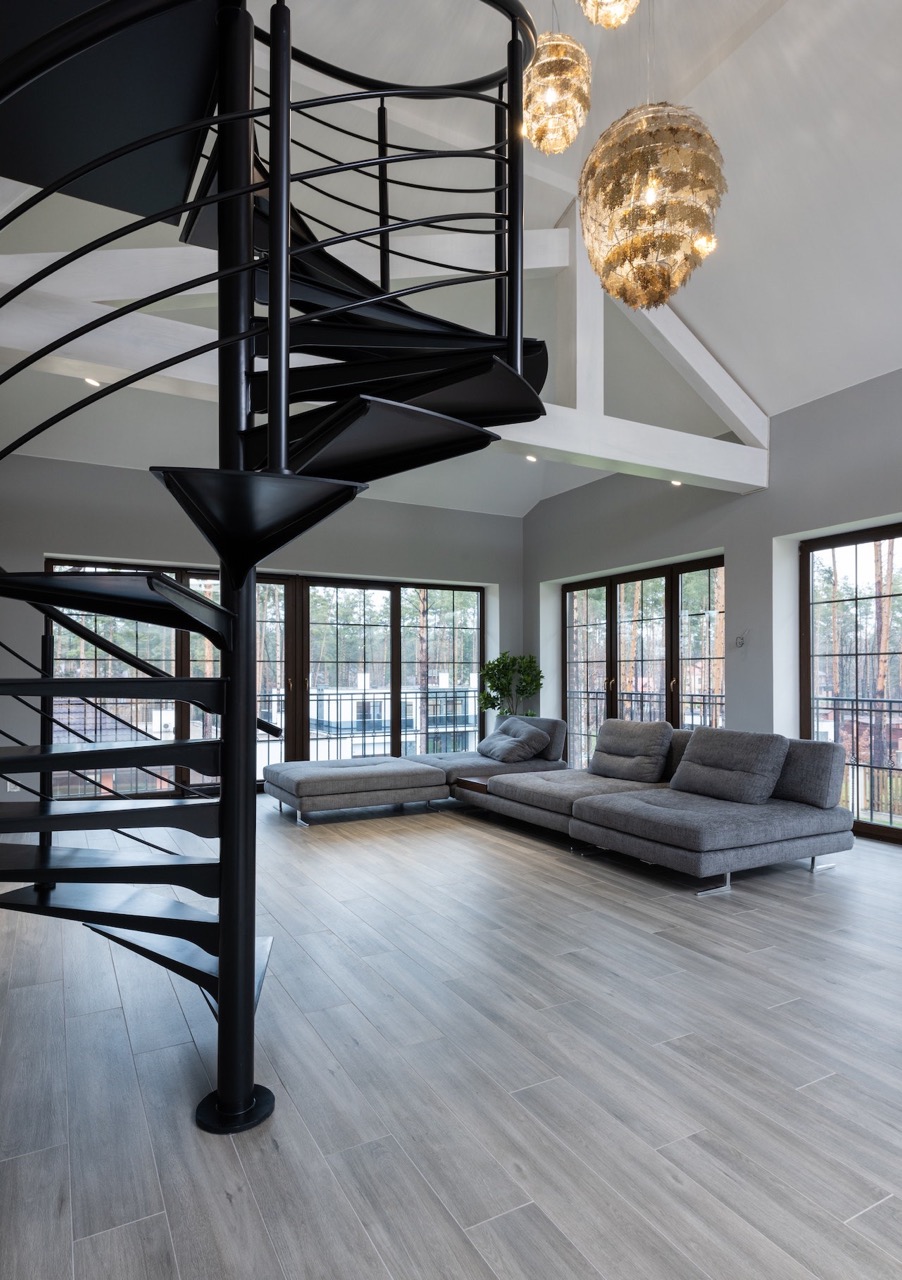Introduction
In the grand tapestry of architectural design, staircases often serve as the intricate threads that interweave spaces, connecting one story to another. These ascensions, however simple or ornate, have not just been about moving from point A to B. Over time, they have evolved from mere functional structures to becoming vital design elements, making statements about the spaces they inhabit and the people they serve.
The history of staircases is as old as human civilization itself. From the grand stone steps of ancient temples to the spiral wooden staircases of medieval towers, and now to the sleek, floating designs in contemporary homes, staircases have undergone a profound transformation. This journey tells a story of not just architectural evolution, but also of societal changes, technological advancements, and shifts in aesthetic sensibilities.
As we stand in the era of modern architecture, where every element is imbued with intent and meaning, staircases find themselves at a fascinating intersection of form and function. This article delves deep into this world, exploring the artistry behind staircase designs, and how they’ve become so integral to the spaces we craft and experience daily.
The introduction seeks to encapsulate the essence of staircases in the realm of design, setting the stage for a deeper exploration into their history, evolution, and the nuances that make them so pivotal in architecture.
Historical Context
From the dawn of human ingenuity, staircases have held symbolic and functional importance. Ancient civilizations crafted them not just as physical connectors, but also as spiritual pathways.
Ancient Symbolism: In many ancient cultures, staircases represented the ascent to divinity. The ziggurats of Mesopotamia, pyramidal structures with successive tiers, were both places of worship and administrative centers. Their stairways symbolized the bridge between earth and the heavens, leading to a divine sanctuary at the top. Similarly, the stepped pyramids of Mesoamerica echoed this notion of ascension and closeness to the gods.
Medieval Mastery: Transitioning to medieval Europe, staircases took on a dual role – that of defense and design. Spiral staircases in castle towers, for instance, were designed with strategic intent. The narrow, clockwise design was deliberate, making it hard for right-handed invaders to swing their swords while ascending. Yet, beyond their defensive purpose, these spiral structures added aesthetic value, often intricately carved and decorated to reflect the affluence and artistry of the era.
Renaissance to Rococo: As Europe transitioned into the Renaissance, staircases became focal points in grand palaces and public buildings. The emphasis shifted from pure functionality to elegance and artistry. Majestic marble staircases, adorned with sculptures and intricate balustrades, became the norm in aristocratic residences. The subsequent Baroque and Rococo periods further embellished these designs, making staircases a true testament to architectural grandeur.
This section provides a condensed overview of the evolution of staircases across ages and cultures. Through historical vignettes, it offers readers a lens to view staircases as more than mere structures – as symbols, defensive tools, and art pieces that reflect the zeitgeist of their respective eras.
Staircases as Architectural Statements
Modern times have witnessed staircases transform from functional elements to definitive design statements. The rise of individualism and architectural experimentation in the 20th and 21st centuries have propelled staircases into the spotlight of interior and architectural designs.
Breaking Conventional Bounds: Modern architects and designers have dared to defy traditional norms. Instead of hiding staircases behind walls or relegating them to the background, they’re now prominently displayed, often becoming the centerpiece of spaces. In contemporary homes, you might find an elegantly curved staircase right at the entrance, immediately capturing attention and setting the tone for the rest of the design.
The Allure of Minimalism: In line with the modern minimalist movement, staircases have adopted simpler, more streamlined designs. Floating staircases, where each step appears to hover in mid-air without visible support, encapsulate this trend. These designs lend an airy and spacious feel, creating an illusion of weightlessness and seamless flow between levels.
Dynamic & Adaptable: Today’s staircases are not just about static beauty; they’re about dynamic adaptability. Movable staircases or those that incorporate storage, seating, or even bookshelves demonstrate this trend. Such designs not only optimize space but also cater to the evolving needs of homeowners.
Integrating Nature: A recent trend in architectural design is the inclusion of nature within built environments. Modern staircases often incorporate natural elements, be it through the use of organic materials like wood or by incorporating planters and greenery into the design. These natural touches help bridge the gap between indoor and outdoor spaces, bringing a sense of tranquility and balance.
In this section, the narrative delves into the transformative journey of staircases in modern architecture. By highlighting trends and innovations, it underscores the changing relationship between humans and their built environment, showcasing how staircases have emerged as an embodiment of contemporary design ethos.
Materials & Their Influence
The magic of a staircase is often deeply intertwined with the materials used to craft it. Each material lends its unique aesthetic and functional traits, which, in turn, dictate the design’s overall impact.
Wood: A timeless favorite, wood brings warmth and organic charm to interiors. From the rustic appeal of weathered oak to the rich elegance of mahogany, wooden staircases can range from traditional to contemporary. Moreover, the flexibility of wood allows for intricate carvings, making it a favorite for designs seeking detail and character.
Metal: Offering both strength and sleekness, metal staircases have become synonymous with modern industrial and minimalist designs. Stainless steel, brass, and wrought iron are popular choices. While steel and aluminum promise sleekness and a futuristic vibe, wrought iron allows for ornate patterns, often seen in balcony railings or vintage-inspired designs.
Glass: An epitome of contemporary luxury, glass staircases exude sophistication. By allowing light to flow freely, they create an illusion of larger spaces, making them ideal for urban settings where space is at a premium. Tempered and laminated glass ensure safety, while various finishes—from clear to frosted—provide design versatility.
Stone: Carrying an aura of grandeur and permanence, stone staircases have graced mansions, palaces, and public buildings for centuries. Materials like granite, marble, or travertine lend an air of opulence, making them fitting choices for spaces that seek to make a statement.
The Role of Lighting in Staircase Design
One of the most transformative elements in staircase design is lighting. It’s not just about visibility; it’s about setting a mood, highlighting features, and enhancing aesthetics.
Ambient Lighting: Soft, diffused lighting provides overall illumination, ensuring safety while creating a welcoming atmosphere. Recessed lights or chandeliers above stairwells can achieve this effect.
Task Lighting: More direct and focused, task lighting ensures that each step is clearly visible. LED strips under treads or wall-mounted fixtures are common solutions.
Accent Lighting: Used to highlight specific design elements—like the curve of a handrail or the texture of a baluster—accent lighting adds drama and depth. Spotlights, wall grazers, or even colored LEDs can bring out the architectural nuances of a staircase.
By integrating varied lighting techniques, designers can accentuate the beauty of a staircase, turning it into a radiant architectural showpiece that beckons and guides.
Through a discussion on materials and lighting, this section emphasizes the multi-faceted nature of staircase design. It underscores the interplay of various elements that come together to craft staircases that are both functional and artistically compelling.
Balancing Safety & Style
In the dance of design, safety and style often emerge as two dominant partners. While staircases should undoubtedly serve as striking visual elements, their primary function of safe passage cannot be compromised.
Handrails & Balustrades: These are essential for ensuring a secure grip and preventing falls. While they serve a clear safety purpose, they also offer ample design opportunities. From ornate wrought iron patterns to sleek, minimalist glass barriers, the range is vast and versatile.
Treads & Risers: The dimensions and materials used for these components are critical for safety. Slip-resistant materials, appropriate tread width, and consistent riser height are vital. Today’s market offers materials that beautifully blend safety with aesthetics, like textured wood or stone with anti-slip coatings.
Visibility: As mentioned earlier, adequate lighting is crucial for safety. However, designers also employ other tactics, such as contrasting colors between treads and risers, to ensure steps are clearly distinguishable, especially in low light.
Innovations in Staircase Design
The world of staircases is not static. With advancing technology and ever-evolving design philosophies, the last few decades have seen significant innovations.
Floating Staircases: A marvel of engineering and design, these staircases appear to be suspended in air. They’re anchored strongly to a wall without visible supports beneath the treads, creating a minimalist and spacious look.
Spiral & Helical Designs: While spiral staircases have historical roots, contemporary versions bring in fresh twists—literally. Helical staircases, unlike spirals, don’t have a central pole, and they curve more gently, making them a favorite in modern commercial spaces and luxury homes.
Multi-story Atrium Staircases: These are grand designs that span multiple floors, often in commercial buildings or luxury residences. They serve not just as a means of transit but also as visual connectors between floors, adding to the building’s architectural narrative.
Eco-friendly Materials: With growing emphasis on sustainability, the use of recycled materials and sustainable wood has gained traction. These materials reduce the environmental footprint without compromising on design integrity.
This segment delves into the balance designers must strike between creating visually appealing staircases and ensuring they remain safe and functional. It also highlights the innovative spirit that drives the world of staircase design, constantly pushing boundaries and redefining norms.
The Socio-Cultural Impact of Staircases
Beyond their immediate functional and aesthetic roles, staircases have had a profound socio-cultural impact, serving as venues for various events and shaping interactions.
Ceremonial Significance: From royal palaces to religious institutions, staircases have hosted numerous ceremonies. The ascending steps often symbolize a journey—whether towards a throne or a spiritual ascent.
Social Interactions: Staircases, especially in public buildings or communal spaces, foster casual interactions. In educational institutions, for instance, staircases can become spots where students gather, discuss, or even engage in spontaneous performances.
Cinematic Influence: Hollywood and global cinema have romanticized staircases. From dramatic descents in ball gowns to intense confrontations, staircases have become iconic settings in numerous films, emphasizing their cultural resonance.
Conclusion: The Future of Staircase Design
As architecture continues to evolve, so will the design of staircases. They’ll likely become more integrated with technology, perhaps with self-lighting steps or smart handrails that can detect and assist users. Sustainability will play a greater role, with an emphasis on materials that are both eco-friendly and durable.
However, the core essence of staircases—their ability to connect spaces and people—will remain unchanged. They will continue to be a blend of form and function, a reflection of the era’s design ethos, and a testament to human ingenuity and the desire for beauty.
Staircases, in their evolving designs and enduring significance, stand as reminders that architecture is not just about buildings and structures—it’s about creating experiences, evoking emotions, and sculpting spaces that resonate with their inhabitants.
In this final segment, the article explores the broader societal implications of staircases and their cultural significance. It also looks ahead, speculating on the innovations and shifts that might shape the staircases of tomorrow, ensuring they remain relevant, beautiful, and integral to the human experience.

